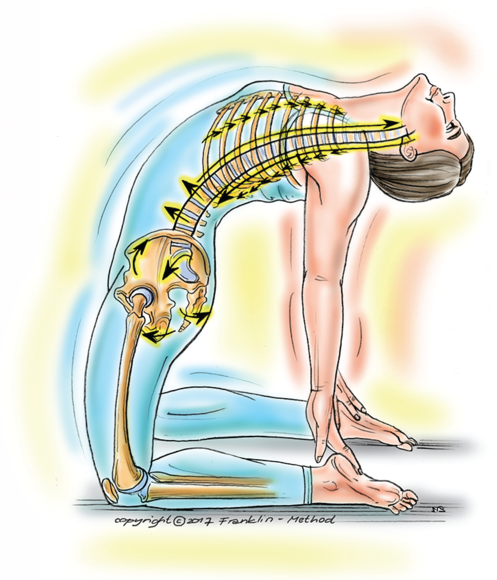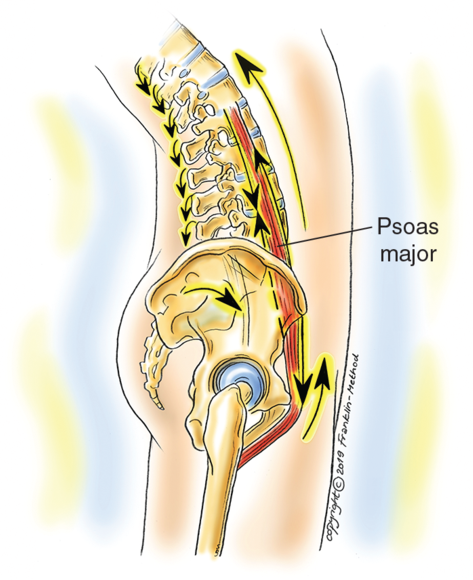Ustrasana: Camel Pose
This is an excerpt from Understanding the Pelvis by Eric Franklin,Alison Wesley.
In this precious backward bend, there is a balance between the muscles of the back creating spinal extension and the muscles of the front like the quadriceps and the abdominals (the rectus abdominis and the oblique abdominals) resisting and decelerating that extension.
Common cues associated with the pelvis and what might go wrong:
- The cue to "tuck your tail" is often preceded by the cue to "protect the lower back." At this point, you understand the very important force absorption aspect of sacral nutation and can see that if the sacrum does the same thing that the pelvic halves do and the entire pelvis moves as one piece, there is no movement or sharing of force throughout the sacroiliac joints, which will create the feeling of tension in the lower back. The problem with tucking the tail is that the tailbone is connected to the sacrum, which is connected to the spine, so if you tuck your tail, you are preventing spinal extension (one of the great benefits of camel pose). The cue engages the pelvic floor, which reflexively engages the rectus abdominis, a spinal flexor. This creates an argument in your body between flexion and extension, which expresses itself in unnecessary tension.
- "Engage your core" or "lift your low belly" creates the same roadblock as the cue to "tuck the tail." It prevents spinal extension and keeps the pelvic floor and the abdominals from serving their function in the pose, which is to contract eccentrically. As noted previously, this cue is not the path to a proper core engagement.
- The cue to "lift your pelvic floor" is tricky because if this action is overdone, it creates the feel of suction or drawing inward of the abdominals. In a backbend, this creates a jutting forward of the rib cage, which can put a lot of unnecessary force on the lower spinal muscles, creating an even more flexible meeting point between the twelfth thoracic vertebra and the first lumbar vertebra (the thoracolumbar junction). More importantly, it keeps us from actually achieving a backbend while creating more of a hinged posture. Too much lifting and engaging of the pelvic floor can also cause stasis of the blood and the lymphatic vessels because they are being compressed.
Possible images, cues, and ways in:
- Cobra is a wonderful preparation for camel pose, because it gives you a palpable sense of the three-dimensional balance in the pelvis. In camel pose, the stakes are a little higher because you are working with gravity.
- "Imagine the pubic bones rolling upward toward your navel at the same time as the tip of your tailbone is sliding down and back toward the wall behind you." A great metaphor for this cue is to imagine the tip of the tailbone as a laser shining back between your feet at the same time as the hip points are lights pointed toward where the wall meets the ceiling in front of you. As with all asanas, the magic ingredient is in the dynamic alignment of this posture: the strategy the body uses to deal with the forces of getting into the pose (figure 54). Trying to feel these actions once you're already in camel pose won't have the same effect as if you focus on them as you're entering into the pose.
- Camel pose also offers a light and lifted feeling in the ribs. Imagine them fanning open in the front of your body. Imagine the sternum to be stretchy like a rubber band.
- The iliopsoas is our most important hip flexor. In camel pose, it aids stability as well as supporting the spine. This is a subtle image, however, because the superficial and the deep parts of the psoas major are not performing in the same way. Sense the deeper layers of the psoas shortening while the anterior layers of the psoas are lengthening (figure 55). This mimics the general pulley feel of the muscles in the back shortening and the muscles in the front lengthening.

Figure 54 Ustrasana (camel pose) with movement of the pelvis, the spine, and the ribs.

Figure 55 Ustrasana (camel pose) with the anterior psoas major lengthening and the posterior psoas major shortening.
More Excerpts From Understanding the PelvisSHOP

Get the latest insights with regular newsletters, plus periodic product information and special insider offers.
JOIN NOW


